| Image | Common name | Scientific name | Distribution |
|---|
 | Square-tailed drongo | Dicrurus ludwigii | southern Africa. |
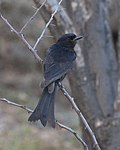 | Sharpe's drongo | Dicrurus sharpei | southern South Sudan and western Kenya to the Democratic Republic of the Congo to Nigeria |
 | Shining drongo | Dicrurus atripennis | Cameroon, Central African Republic, Republic of the Congo, Democratic Republic of the Congo, Ivory Coast, Equatorial Guinea, Gabon, Ghana, Guinea, Liberia, Nigeria, Sierra Leone, and Togo. |
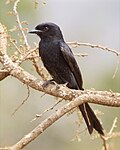 | Fork-tailed drongo | Dicrurus adsimilis | Gabon, Congo Republic, DRC, Angola, northwestern Zambia, Namibia, Botswana and northwestern South Africa |
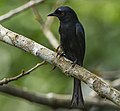 | Velvet-mantled drongo | Dicrurus modestus | Nigeria and Cameroon to the Democratic Republic of Congo and Angola. |
| Grande Comore drongo | Dicrurus fuscipennis | Comoros. |
 | Aldabra drongo | Dicrurus aldabranus | Seychelles |
 | Crested drongo | Dicrurus forficatus | Madagascar and Comoros |
| Mayotte drongo | Dicrurus waldenii | Mayotte. |
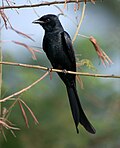 | Black drongo | Dicrurus macrocercus | Iran through Pakistan, India, Bangladesh and Sri Lanka east to southern China and Indonesia and accidental visitor of Japan |
 | Ashy drongo | Dicrurus leucophaeus | eastern Afghanistan east to southern China, Ryukyu Islands in southern Japan (particularly Okinawa) and Indonesia. |
 | White-bellied drongo | Dicrurus caerulescens | India and Sri Lanka. |
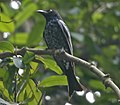 | Crow-billed drongo | Dicrurus annectens | Bangladesh, Bhutan, Brunei, Cambodia, China, India, Indonesia, Laos, Malaysia, Myanmar, Nepal, Philippines, Singapore, Thailand, and Vietnam. |
 | Bronzed drongo | Dicrurus aeneus | western Uttaranchal eastwards into Indochina and Hainan, the Malay Peninsula, Sumatra and northern Borneo |
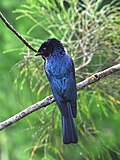 | Lesser racket-tailed drongo | Dicrurus remifer | Bangladesh, Bhutan, Cambodia, India, Indonesia, Laos, Malaysia, Myanmar, Nepal, Thailand, and Vietnam. |
 | Balicassiao | Dicrurus balicassius | Philippines. |
| Short-tailed drongo | Dicrurus striatus | Philippines. |
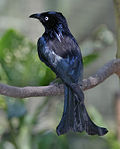 | Hair-crested drongo | Dicrurus hottentottus | Bangladesh, India, and Bhutan through Indochina to China, Indonesia, and Brunei. |
| Tablas drongo | Dicrurus menagei | Philippines. |
| Palawan drongo | Dicrurus palawanensis | Palawan. |
| Sumatran drongo | Dicrurus sumatranus | Sumatra in Indonesia. |
 | Wallacean drongo | Dicrurus densus | Indonesia and East Timor. |
 | Sulawesi drongo | Dicrurus montanus | Sulawesi in Indonesia. |
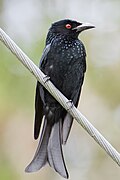 | Spangled drongo | Dicrurus bracteatus | Australia, New Guinea, Indonesia |
| Paradise drongo | Dicrurus megarhynchus | New Ireland in the Bismarck Archipelago, Papua New Guinea. |
 | Andaman drongo | Dicrurus andamanensis | Andaman Islands |
 | Greater racket-tailed drongo | Dicrurus paradiseus | India to Borneo and Java |
 | Sri Lanka drongo | Dicrurus lophorinus | Sri Lanka. |
|
































